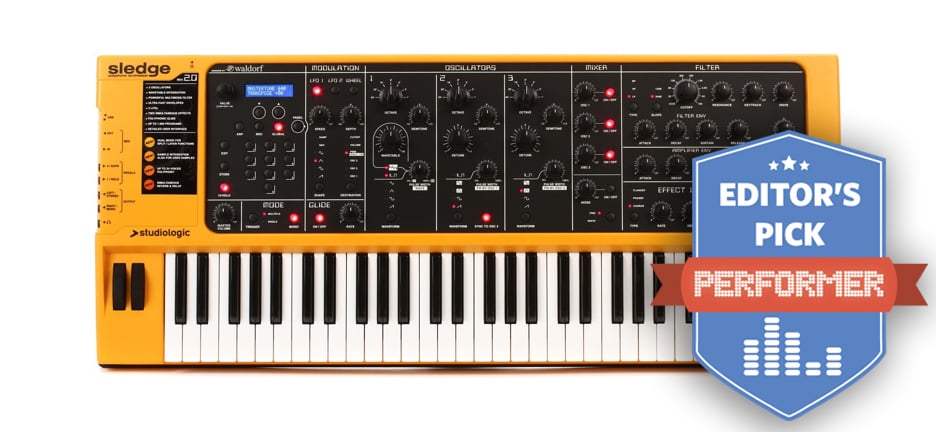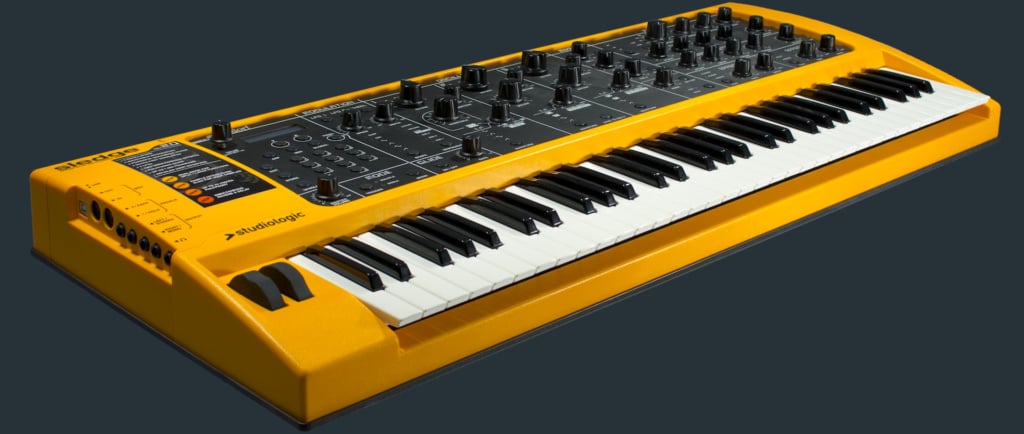The Studiologic Sledge 2.0 is the best virtual analog synth you can buy under $1000
RELATED:
- The Overall Best Synth Under $1000
- The Most Versatile Synth Under $1000
- The Best Bottom-End Synth Under $1000
- The Best Synth Re-Issue Under $1000

Studiologic Sledge 2.0 – the best virtual analog synth under $1000
WHY WE LOVE THE STUDIOLOGIC SLEDGE 2.0:
Can we start with how amazingly awesome (and how very Italian) the orange case is on the new Studiologic Sledge 2.0? Some call it school bus orange, which is what we’ll stick to, as well. In the world of synthesizers, you’ve got your analog purists, your digital enthusiasts and your “I’ll take whatever I can get as long as it’s nice to play and sounds good.” I fall into that camp, which is precisely why I wanted to get my hands on the Sledge 2.0. I don’t care that it’s technically a “virtual analog” synth (a most bizarre category if I’ve ever heard one). I just wanted to know how it sounded ever since I saw it demo’d at NAMM. And compared to some of the other VA boards I’ve used in this price range, the Sledge 2.0 simply kills the competition.
Studiologic Sledge 2.0 Sound Samples:
If anything, it’s one of the most “analog” feeling digital boards I’ve ever played. In fact, the panel is laid out in a very Moog-like fashion, which makes you feel instantly at home and at ease. You can select from like a thousand patches, which is great, but you can also go into panel mode and play the Sledge like a true analog synth. We loved the feel, and as you may or may not know, Studiologic makes a great majority of the keybeds you’ve probably played, so this one was certainly no slouch. Aftertouch? You got it! And the full-size keys and 5-octave range means that traditional pianists will favor something like this over, say, a two-octave monophonic Sub Phatty (which is our pick for the best overall synth under a grand).

Studiologic Sledge 2.0 side view
If you want to know what’s new compared to its predecessor (the Sledge 1.0, if you will), the first thing you’ll notice is a much-needed bump in polyphony, up to 24 voices now. Add that to the fantastic Waldorf sound engine the synth runs on, and you’ll never been at a loss for a great patch. Also new are the simultaneous reverb and delay effects. Good, not great, but definitely usable. What are totally useable, however, are the filter sections, the surprisingly nice envelopes (both filter and amp ADSR’s) and the unique wavetable you can select from in oscillator one. With three oscillators in total, each with its own separate tuning capabilities, you can really stack, tune and layer waveforms to concoct ultra-thick, lush sounds very quickly and easily. With a multitude of modulation effects and routing options, you can imagine why we stayed up until the wee hours some nights just dialing in new pads and lead patches on this bad boy.
Don’t let editors touch the gear.
A video posted by Performer Magazine (@performermagazine) on
WHY YOU SHOULD BUY THE STUDIOLOGIC SLEDGE 2.0:
If you simply want a full range of octaves for more traditional playing, dig the orange casing and need a ridiculously versatile digital engine to power your stage show and studio work, the Sledge 2.0 might be just the ticket. While the casing was just a tad plastic-y for our tastes, the great sound engine and easy-to-use panel put this unit over the edge, and made the newly reduced $999 price tag much easier to swallow over the more expensive Sledge 1.0. MIDI implementation was great, too, allowing you to use most of the front panel knobs and buttons to control data to and from your DAW, which makes this machine not only a great standalone synthesizer, but also a fantastic MIDI controller.
PROS:
Sounds great, layout is very analog-like, great MIDI implementation, large keyboard is a welcome addition in this price range, lots of improvements over the original Sledge.
CONS:
User sample memory is weak, some noticeable zipper noise when making quick adjustments (but not too bad).
PRICE:
$999
A photo posted by Performer Magazine (@performermagazine) on
Studiologic Sledge 2.0 Specs:
-61 key polyphonic synthesizer with Aftertouch
-Enhanced polyphony, up to 24 voices
-Split or Layer mode, play two sounds at the same time
-Up to 999 programmable Sounds
-Fast and efficient sound selection via numeric keypad
-Enable Pitch and the Hold separately for the Lower and Upper sounds
-Enhanced Reverb and Delay effects with blend control
What do you think of our review of the Studiologic Sledge 2.0 virtual analog synthesizer? Let us know in the comments below or drop a line on the Performer Magazine Facebook page or on Twitter @Performermag. And be sure to read more from the special Synth Issue of Performer Magazine.
